Phil Boname & Antoine de Saint-Exupéry
Thursday, November 30, 2006

In my Buenos Aires fourth grade class our teacher Miss Zimmerman treated us as precocious children. We read passages from "adult" books in class. One I will never forget was Antoine de Saint-Exupéry's Night Flight. In 1929 Saint-Exupéry had moved to Buenos Aires where he was appointed director of the Aeroposta Argentina Company. His experience, flying post through the Andes was the basis for Night Flight, his second novel.
Reading about a tiny plane being buffeted by terrible wind currents while crossing the Andes in Night Flight made me fear for my life when in 1953 I was on board a PANAGRA Douglas DC-6 crossing from Buenos Aires to Santiago, Chile. Since the airliner was not pressurized we were given oxygen masks. Lightning, thunder and wind plus my airsickness had me holding on to my mother and grandmother who must have been as afraid as I was. I have never really felt safe in an airplane since. But that has not stopped me from being fascinated by them. I remember in 1957 going to the Bergstrom US Air Force base outside Austin, Texas. It was thrilling to pass my hand on the almost razor edge of a Lockheed F-104-A Starfighter.
So it was a special occasion to photograph Vancouver businessman Phil Boname. Calling him up for the appointment in my studio on February 12, 1990 he somehow revealed that as a little boy in France his father had been a friend of Saint-Exupéry. The author would pass his hand through Phil's curly hair and that became Saint-Exupéry's inspiration on how the little prince should look. Saint-Exupéry also illustrated The Little Prince.
For my photograph I brought my daughter Hilary's Argentine leather bomber with Argentine Air Force patches. I also brought my treasured P-38 Lightning by Jeffrey L. Ethell and illustrated by the incomparable Rikyu Watanabe. It was in a Lockheed F-5B, an unarmed reconnaissance variant of the P-38, that Saint-Exupéry flew in 1944 and was never seen again.

On July 31, 1944 at a quarter to nine in the morning, Saint-Exupéry took off from an airstrip in Sardinia on a flight to photograph the Grenoble and Annecy areas. He never returned. He left behind a letter addressed to General X. It read:
"I do not care if I die in the war or if I get in a rage because of these flying torpedos which have nothing to do with actual flying, and which change the pilot into an accountant by means of indicators and switches. But if I come back alive from this ungrateful but necessary "job", there will be only one question for me: What can one say to mankind? What does one have to say to mankind? "
His P-38 was found in the Mediterranean in May 2000 with no signs that it had been shot down.
Daniel Rutley - Clinical Psychotherapist
Wednesday, November 29, 2006
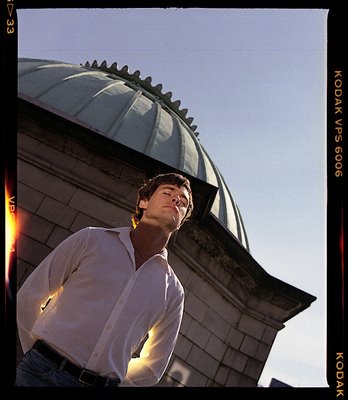
On a hot afternoon of June 1987 I spent several hours with Daniel Rutley, clinical psychotherapist on the cupola of the Vancouver Art Gallery. I was up there because John Lekich, one of the most well-adjusted persons I have ever met (except when giving advice on how not to wear a bow tie with a button down shirt), decided to write a story called Changing. It was about dealing with the inevitable crossroad most of us take sometime in our life about shifting our direction. Going through the red tape in order to get on that roof would have been enough to have made me seek Daniel Rutley privately.
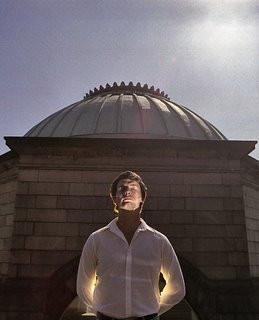
Western Living Magazine art director Chris Dahl (a well adjusted psychedelic band drummer turned designer) had called me one day and told me, "I have this neat assignment but I want you to shoot it differently. You always print your own b+w negatives. This time around I want you to shoot in colour and I want you to print your own at home." If that wasn't enough he told me he wanted me to photograph my subjects (Daniel Rutley was one of them) with mirrors in unusual places.
This job was so tough that to this day all I remember of Daniel Rutley is that he was very quiet and I tried to avoid his gaze.
Daniel Rutley
The Funky Redhead Survives Another Year
Tuesday, November 28, 2006
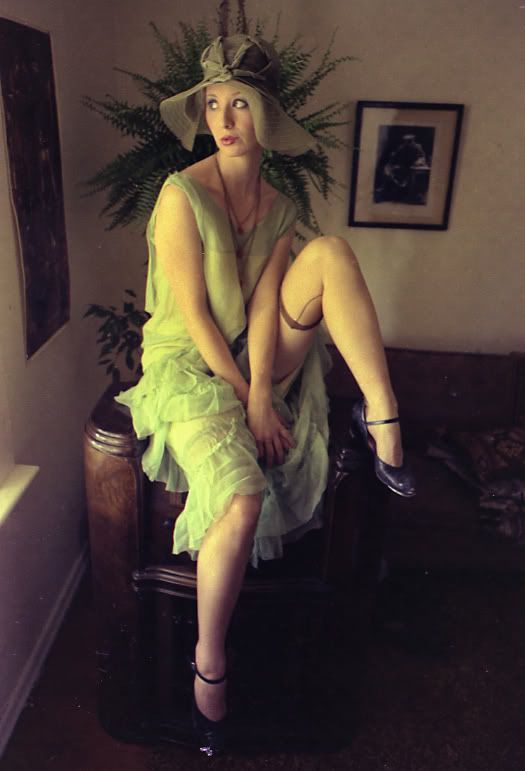
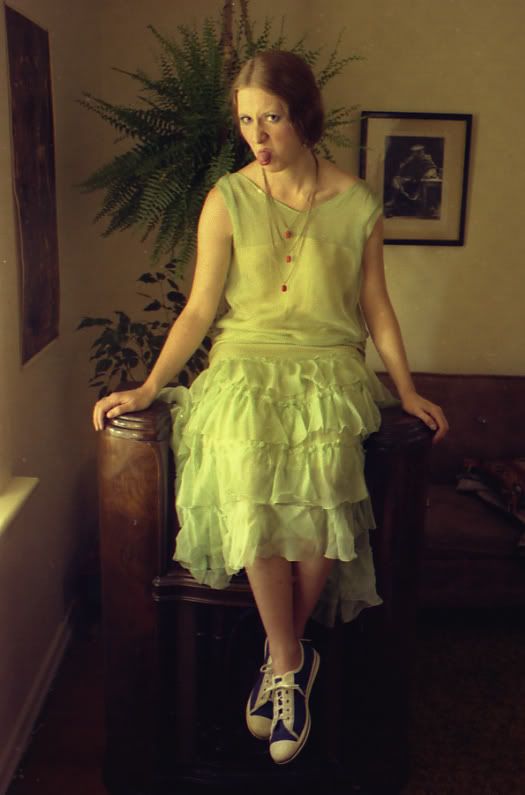
Every year, at about this time, I begin to think about making my once a year purchase at Holt Renfrew. They are the only ones that sell the Graphic Image agendas. Holt Renfrew will put my initials in gold if I order my copy in time. I did not do that in 2006 so the 2005 agenda is here instead. These agendas, unlike the Lett's diaries I used to buy, still have a section for writing people's names and phone numbers. This is crucial as by mid December I play the sad game of God. As I transfer names and phone numbers from one diary to the next there are people who I eliminate for one reason or another. I am sure that at the the push of a Blackberry button I must also cease to exist many times during December.
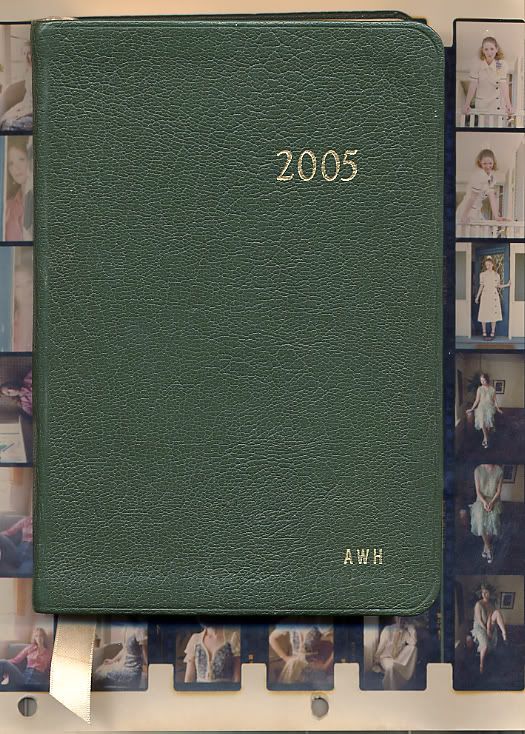
It was at least 12 years ago that my eldest daughter, Ale began to file my negatives, slides and photographs. Every year I look at a white envelope that she marked as funky redhead. I photographed her some 30 years ago. I have long forgotten her name or circumstances. I do remember that she paid me for acting shots. I processed the colour negative film in my home lab and even printed the 8x10s.
The funky redhead has survived another year in my files. And here she is. I wish her all the best wherever she is now.
Jocelyn, Jocelyn & Joselina
Monday, November 27, 2006
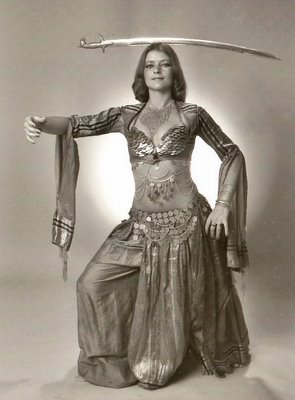
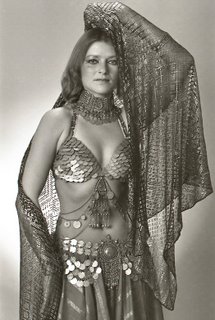
In the 70s Greek restaurants were most popular in Vancouver. Most of them featured belly dancers. There were good ones like , Sarita and Jocelyn. I first met Jocelyn in the late 70s in that joint on Main and Powell. She had the ambition to become a belly dancer so she asked me to photograph her. A few years later I photographed another dancer, also called Jocelyn. She recently died of cancer. Back then she was noted for her demure expression and her voluptuous body.

In the late 80s Rosemary and I attended and Equity Magazine Christmas party. Ronald Stern, the publisher always rented the best restaurant in town and always had unusual entertainment. This time around it was a Flamenco singer. When he began to sing Rosemary and I laughed. It seemed to be as sad lament to most there but we knew better. This is what he sang in Spanish:
Rich men get to shave with hot water.
Alas! This poor one must scrape his face with cold water.
The pain! The pain!
And he sang this on and on. Suddenly a flamenco dancer with black hair entered the room. Her name was Joselina. She winked at me and we laughed again. The belly dancer had intelligently read the restaurant trend of our city.
Young, Sexy & Well Heeled
Sunday, November 26, 2006
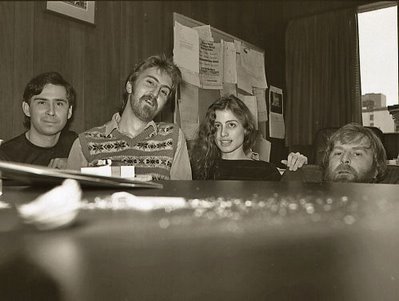
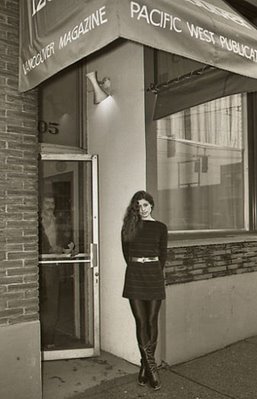
One of the most influential critics of the 1920s and 1930s was H.L. Mencken. He created the expression Bible Belt to refer to the ultra conservative South and while bootleggers reached auspicious heights as booticians, the middle class was reduced to the booboisie. So in 1940 it was a Baltimore stripper that asked him to come up with a unique word to raise the tenor of her profession. Georgia Sothern wrote to Mencken, "I am a practitioner of the art of strip-teasing...there has been a great deal of...criticism leveled against my profession. Most of it...arises from the unfortunate word strip-teasing, which creates the wrong connotation...if you could coin a new and more palatable word to describe this art, I and my colleagues would have easier going. I hope...(you) can find time to help the...members of my profession."
Mencken replied to Ms Sothern, "I sympathize with you in your affliction. It might be a good idea to relate strip-teasing in some way to the...zoological phenomenon of molting,...which is ecdysis. This word produces...ecdysiast."
Young, Sexy & Well Heeled - that was the title of Les Wiseman's "business"article on the vancouver stripping industry in the March 1982 issue of Vancouver Magazine. At the time Les and I spent a considerable time (when we weren't extremely busy trying to make ends meet)in strip parlours or strip joints. We followed our favourite strippers from one joint to another. We determined that there had to be a way of conning Vancouver Magazine editor, Mac Parry into assigning us to do a piece on the subject of stripping. Les found the angle which Mac immediately accepted. The article would have to do with following the money trail of the business. It was to be a business story. One of our fave dancers was Danielle, she of the rose tattoo on her upper left thigh. A few years later she took her S+M act (complete with lots of fake blood) to the first ever Golden G String Convention in Las Vegas and shocked the then tame Vegas audience.
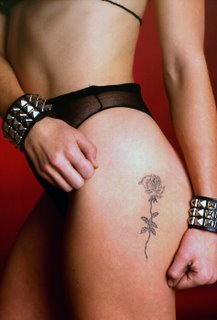
In an attempt to be objective, Les interviewed the ecdysiasts at the old Vancouver Magazine office on Davie and Richards. From left to right that's me, Les, Danielle and Mac, almost under the table.
The other article I was working on was Sean Rossiter's story, One Cat's Fight Against Cancer. It was a personal story about his own cat. While watching strippers at the nearby Cecil Hotel, I remember vividly Mac telling me, "Alex, go home and photograph your cat. Make sure his whiskers are razor sharp. We are going to put him on the cover." For a while there was the idea of producing a March issue with two different covers, one with the cat and the other with a stripper languidly blowing bubbles in a portable tub at the Drake Hotel stage. In the end publisher Ronald Stern nixed the idea.
Earthworms
Saturday, November 25, 2006
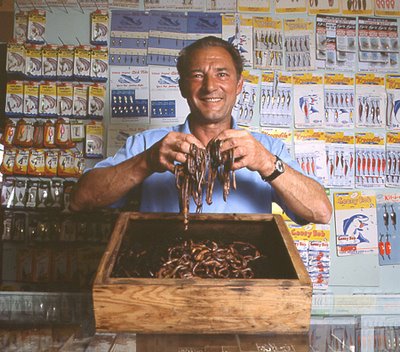

Earthworms
Class Oligochaeta
Phylum Annelida
Earthworms belong to a large phylum, the Annelida, or segmented worms. They belong to the Class Oligochaeta. This name means 'few bristles' and refers to the few bristles, or setae, on each body segment compared with the many setae of marine annelids in the Class Polychaeta ('many bristles'). There are four pairs of setae on each segment. These can be detected as a roughness if the animal is stroked from tail to head.
Earthworms are diverse enough to be broken into four major families, with approximately 3,000 known species.
Earthworms range in size from several millimetres to two or three metres in length.
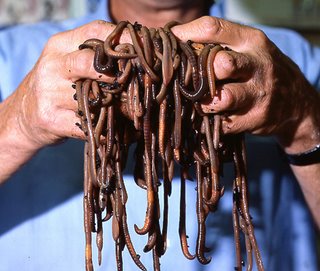
I took these pictures around 26 years ago and I don't think Martin's store is around anymore. I remember the store was near Kootenay Street in East Vancouver, and that's all. I wouldn't be caught dead holding more than one earthworm in my hand at a time. Being an Argentine by birth I really don't like to eat fish. I get easily seasick, so fishing is something I have avoided all my life, be it manly or not.
But Rebecca Stewart, my 9-year-old granddaughter, begs to differ. Whenever she spends any time in our garden she overturns all my stones to look for insects, worms and other bugs. These she picks up and brings them into the house for me to scan. When she was 5 and we went to Washington DC, she had a fantastic time holding 5-inch long cockroaches, lizards, snakes and whatever creepy crawly thing she could get her hands on at the Museum of Natural History. Her mother Hilary has nixed Rebecca's wish to become a member of the Vancouver Reptile Society and has said that a snake in the house is out of the question.
No longer mourn for me when I am dead
Than you shall hear the surly sullen bell
Give warning to the world that I am fled
From this vile world with vilest worms to dwell:
Nay, if you read this line, remember not
The hand that writ it, for I love you so,
That I in your sweet thoughts would be forgot,
If thinking on me then should make you woe.
O! if, I say, you look upon this verse,
When I perhaps compounded am with clay,
Do not so much as my poor name rehearse;
But let your love even with my life decay;
Lest the wise world should look into your moan,
And mock you with me after I am gone.
William Shakespeare, Sonnet 71
Greek To Me
Friday, November 24, 2006
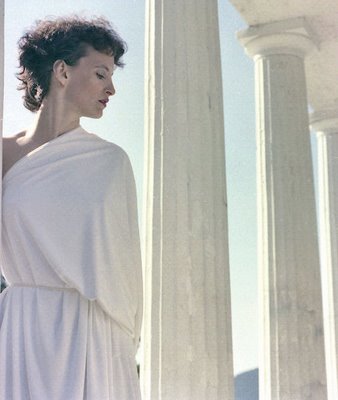

During the olympics in Mexico in 1968 Rosemary and I attended many of the cultural olympic events. One of them was a classic Greek play with actors who came from Greece. I remember that the only two words I understood during the very long evening were nous and antropos.
In Vancouver around 1978 one of the closest kept little secrets was the existence of Parthenon Place in West Vancouver. I guess those who lived in West Vancouver knew of it and kept their mouths firmly shut. Those who might reveal the existence of the little Greek temple to the lesser mortals of Vancouver would have probably been ostracized and banished to cross First Narrows and live on the other side for life.
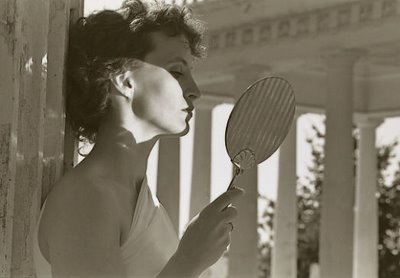
I discovered the pseudo Greek parthenon by accident from the air in a De Havilland Beaver coming back from Egmont. The story I was told was that a rich Greek businessman tried to placate his wife's homesickness and built her the temple that she could see from her window. The little temple was pretty well intact into the 90s and one day it was gone. A little memory of the place remains in a couple of streets called Parthenon Place and Parthenon Crescent.
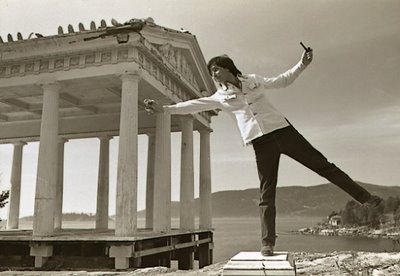
Greer Grimsley (Macbeth), Christopher Gaze (Richard III), Nick Harrison (English Soldier)
Thursday, November 23, 2006


Nick Harrison (actor/sword master/stunt performer) sat on a stool in my living room wearing his chainmail, a mantle, chainmail gauntlets and broad sword. With his short cropped hair (as if he had just removed his helmet) he looked like an English soldier after the battle of Agincourt. A couple of hours later American baritone Greer Grimsley, in town for Vancouver Opera's performance of Verdi's Macbeth, was in my studio facing my camera and wearing Harrison's equipment. Harrison had kindly lent it to me for the Georgia Straight photograph. In 1950 when my mother first visited Mexico from Argentina she was given a rough textured, blood red rebozo that I have lovingly kept and used for special photo sessions. When Grimsley saw it he said, "This is perfect. In Macbeth's time they did not yet have tartans. This will be look accurate." While I was taking my photographs I kept thinking of the interesting link between two of my protagonists here and Bard on the Beach's Christopher Gaze. In the hopes of catching a glimpse of Kenneth Branagh (see in blog below) Gaze accompanied me when I photographed Branagh. In 1998 I photographed Gaze in his 1998 appearance as Richard III.
Adendum by Nick Harrison (who is the fight choreographer for this opera) on sword seen here:
It is a bastard sword. It's called a bastard sword because it can be used with one or two hands. The story behind that sword is that it was the very last sword made by my father. He was 87 - He made that one in July of 2006. He died August 2006. The pommel on the sword is a lion rampant.
Nick

The sword in the photo was Branagh's from his 1998 film Henry V. When I was desperately trying to find a broad sword for my Macbeth session it was Gaze who pointed me in Harrison's direction. And here they all are!
Vancouver Opera's Macbeth
Bard on the Beach
Kenneth Branagh (Hamlet), A Bodkin & Helena

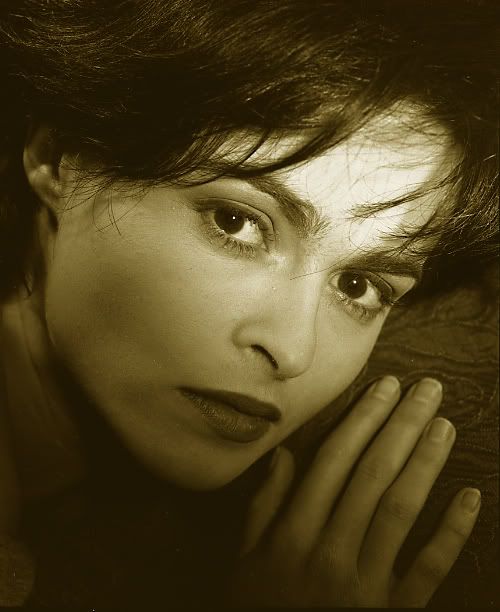
On January 10, 1997 at 3:45pm I was to photograph actor Kenneth Branagh at the Hotel Vancouver. He was here on a publicity tour for his film Hamlet, in which he starred and directed. Days before, in an advance screening, I had seen Hamlet (the long two-hour, 42 minute version.
For the ever-so-familiar "To be, or not to be" soliloquy, Branagh ignored previous stage versions and took advantage of the unique capability of film. He performed it in front of a large mirror in a black 19th century military uniform with a stark checkered floor as background. I was enthralled.
When he himself might his quietus make
With a bare bodkin? who would these fardels bear...
From his side he pulled out a bodkin(stilleto) and finished the soliloquy with it by his face. I knew how I was going to take my picture. Upon leaving the screeing room, I told the publicist's assistant, "It's going to involve a dagger."
The morning of my shoot, I was called by Branagh's Vancouver publicity agent and warned, "Under no circumstances are you to photograph Mr. Branagh with a dagger or a dirk. He is here as himself, not as Hamlet. Furthermore, you are not to raise the subject of her."(at the time, Branagh and Helena Bonham Carter were an item.)
I was ushered into Branagh's suite and I set up my lights. He came in but left the door ajar. His agent was in the other room. Branagh was a delight to photograph, but I kept eyeing my briefcase. Pointing in its direction, he whispered, "What's in it?" I opened it. He lifted the bodkin and placed it on the side of his face. I took my picture. Before leaving I gave him a little pewter frame with my portrait of Helena, taken a year before.
Shaking my hand, he said warmly, "I'll make sure she gets it."
Lauren Cries - Hilary Cries - Ale Doesn't
Wednesday, November 22, 2006
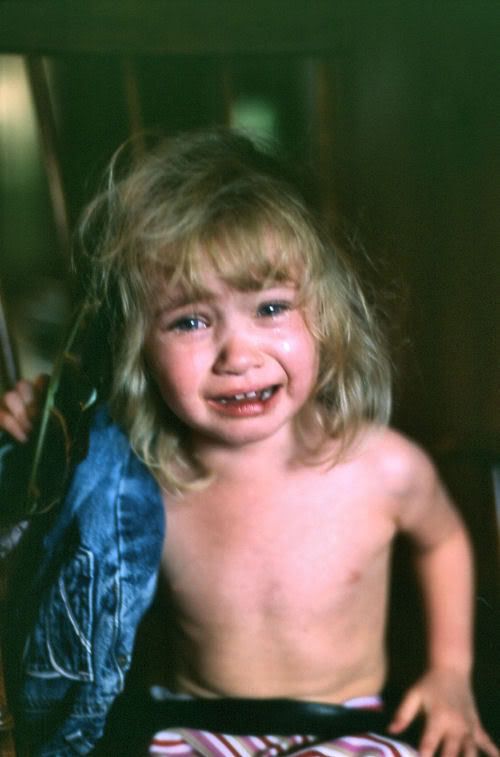


When we are born we cry that we are come to this great stage of fools.
King Lear, Shakespeare
I remember distinctly 32 years ago when I placed my youngest daughter Hilary (she was about 2) on a high shelf in our home in Arboledas, Estado de Mexico, in the outskirts of Mexico City. She was afraid and she began to cry. In my youth I may have been even more callous as I had the intention of wanting her to cry so I could take this picture. Hilary cried for everything. She may have been four when we traveled in our VW to San Francisco with her older sister Ale. While there, she spoiled our holiday as she cried and cried for beans and tortillas and would only stop crying when Rosemary carried her. On our way to San Francisco we drove through the scorching Desierto del Altar near Mexicali. Hilary cried in the back seat. I would shout to Ale to make her stop crying. Could it have been my shouting or my saddling Ale with the responsibility of caring for her that I can say that I have no memory of having ever seen Ale cry? The paradox is that only recently I can attest to the fact that Hilary has finally lived up to her name and she laughs a lot with that crooked smile she inherited from me which I inherited from my mother.
Now I will do anything to stop a child or any woman from crying. When Rebecca cries for a stuffed bear, I have told her that if I were rich I would buy anything for her as long as she stopped crying.
Lauren, who is now 4 is crying for her mother in the same way her mother cried for us. I don't take any comfort. Last Saturday Lauren was running around with a pair of jeans on her head (much like her mother used to do). She looked cute so I asked her to pose for me. She told me she didn't want to and began to cry. With the light at a minimum I took these pictures and felt sorry I had. It will be a while before she understands exactly how bad I felt.
Harry Nomura - Larix kaempheri
Tuesday, November 21, 2006
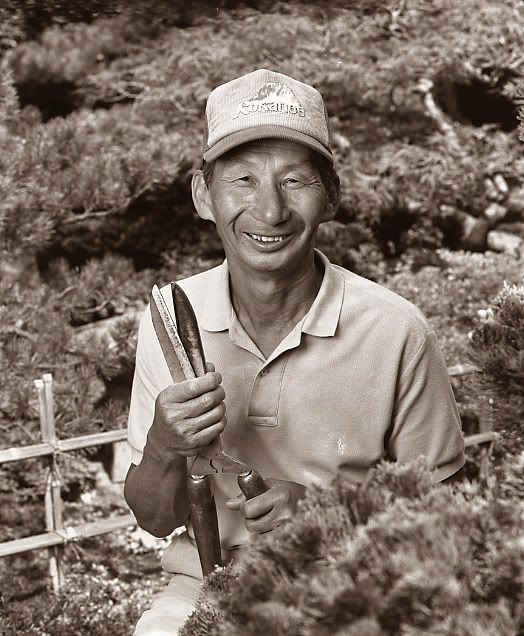

When Rosemary and I moved to our present home on Athlone Street in 1986 me moved to a house with a large garden in total ignorance. The previous owners had relied on Harry Nomura to take care of the garden. Nomura had been doing the gardens of our neighbourhood for a long time and when he retired (his eyes were giving out) in 2000 I would guess he had been at it for over 50 years. Nomura always looked younger than he was. In a short time Rosemary and I realized we could not afford Nomura except for the needed spring and fall cleanups and the clipping of tall trees. We had to do the rest if we were going to pay our mortgage. And that's how the both of us got into gardening. But for a long time Rosemary would correct anything I would be doing in the garden with a, "Alex, Harry would not do it that way."
Eleven years ago I purchased a 5 ft Larix Kaempheri (Japanese larch) at the VanDusen spring plant sale. When I was leaving the garden with the tree in my wheelbarrow, VanDusen curator, Roy Forster looked at tree and then at me. He said, "It's going to be big." He was right. The tree has been growing a meter per year and has surpassed in height the Lawson Cypress behind it that it will replace as soon as the dying Lawson Cypress finally dies. The Lawson Cypress has hung on.
One day in 1999, around this time of the year, Harry saw my larch and told me, "Tree dead."
Our conversation after that went like this:
"Tree not dead."
"Tree dead"
"If tree not dead you do garden free."
"Tree not dead."
In about a week or so all the needles will fall within hours. When I bought the tree, Roy Forster warned me of its eventual size, but he never told me that my evergreen wasn't. In the photo here you can see what my larch looked like yesterday
Madeleine Morris, A Pet Rat & No Walkies
Monday, November 20, 2006
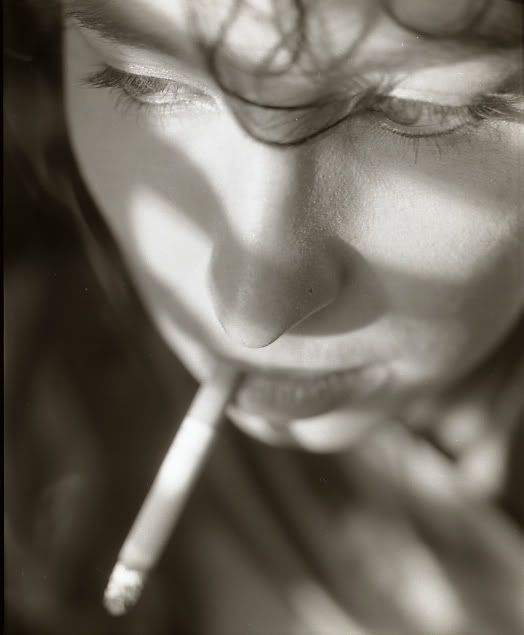
I have read many novels in which protagonists are described as having all the wrong features that, somehow, all add up on the plus side. Such was the case of Madeleine Morris.
It must have been somewhere around 1985 when I first saw her. She was in a crowd at a punk concert. She was wearing blood red lipstick and had a cigarette drooped in her mouth all the time. She had mastered the skill of keeping it lit without the smoke ever getting in her eyes. Her nose was big and her mouth even bigger. She might have had thick and beautiful black hair but it was cropped short and in later years she never let it grow out. I photographed her for the first time because she was the lead singer of a band called Moev. It was an artsy alternative scene band that worked only because of her on-stage presence even if she was barely 5ft tall. I photographed her at home with her pet rat. "I don't have to take him out for walkies, " she said.
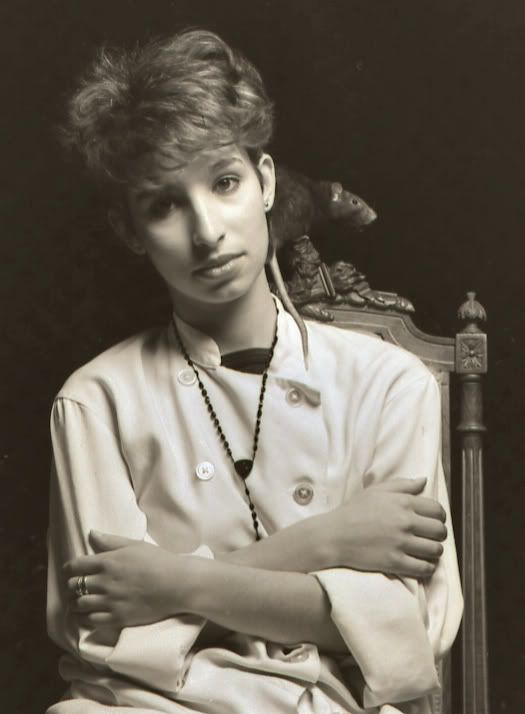
Madeleine Gothic

Coleen Hughes - Lighthouse Park
Sunday, November 19, 2006
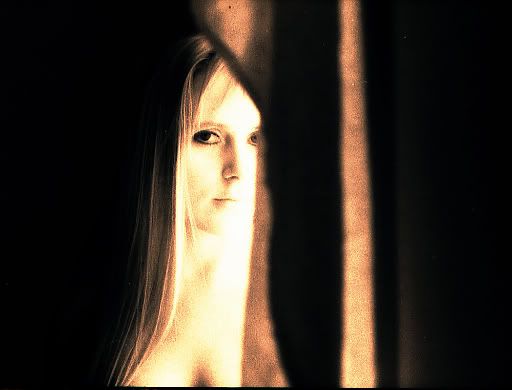
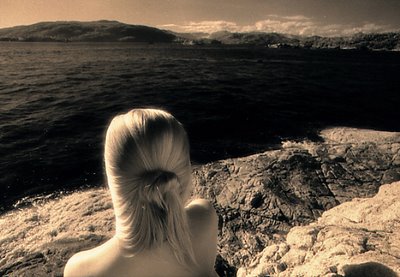

When I only depended on the work that I could crank out from my wet (an enlarger, photo trays and photographic paper) darkroom I could only print what I had time to do and many good photographs never made it past a quick glance at a contact sheet. As my contact sheets added up to thousands, many of these photographs I simply almost forgot in my memory. This blog has re-awakened my past in the same way as my present and ongoing re-filing has. Recently I received a communication via this blog from Coleen Hughes who lives in Alberta. She was one of my muses in my past who patiently allowed me to experiment with my camera, film types and lighting techniques. Her only reward were my 8x10s. These pictures that you see were from my environmental period. At the time my film stocks were Kodak's b+w infrared film and Technical Pan Film. I think that in my policy of not posting revealing nudes here these photographs of Coleen and her beautiful hair pass muster.
Coleen & Son in Tub

And here is Coleen and her son. And yes he did what he was supposed to do in the tub.
Elmore Leonard, John Lekich, A Lazy Gourmet & Mary Hart
Saturday, November 18, 2006
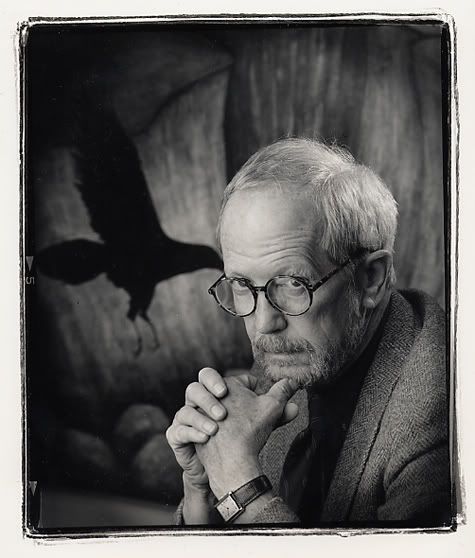
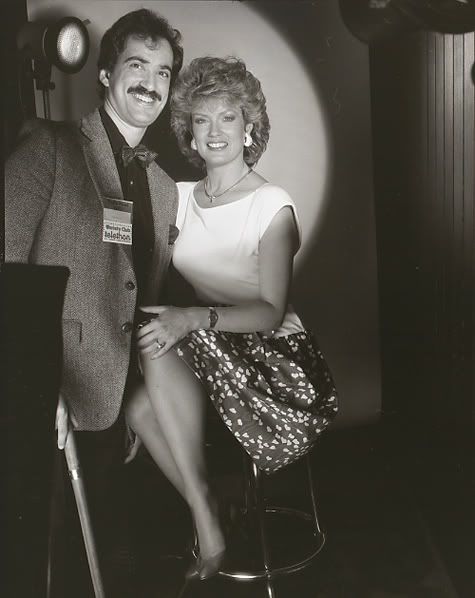
My author files in the Ls go as follows Lau ( Evelyn), Lekich (John), Leonard,(Elmore). I will concentrate on the two men. Both are gentle and have a way with words. Fueled by a Lazy Gourmet hamburger Leonard, in Vancouver in 1993, explained about his books to Globe & Mail writer Christopher Dafoe. I realized that I could not take a decent photo of the writer in the restaurant so I sped to the nearby Diane Farris Gallery and asked Diane if she would allow me to photograph the writer. She did not know who the author of one of my favourite crime novels (City Primeval - High Noon in Detroit) was but she cheerfully gave me the nod.
Lekich is equally fueled by hamburgers, of the Red Onion kind. He is known as the gentleman's getleman and a gentle juvenile novel author (Governor General nomination, too!), which is a pity. In an excercise in Rick Staehling cross casting, If I were an editor, I would unleash Lekich who would rapidly become the attack dog of satire and criticism, something this city sorely needs. Luckily I can enjoy it all in our private telephone conversations or in our occasional visits to jazz lounges. Here he is in his Emiliano Zapata period (1987) with Mary Hart.
Lady Di & A Malvinas Security Risk
Friday, November 17, 2006
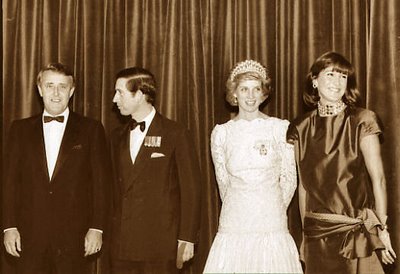
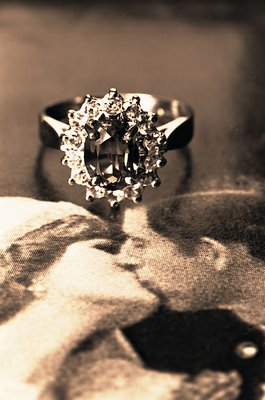
In 1982, during the war over the Malvinas (Falklands) Vancouver Magazine editor, Malcolm Parry suggested I write my story of having been in the Argentine Navy and my participation in a coup to oust gentle and honest president Arturo Illía. It made the cover and Mac himself took the cover photo (below). I agreed with Jorge Luis Borges that the war was really a war between two bald men fighting over a comb. It still left me with a bit of animosity towards the Brits even though my father had been born in Manchester. In 1983 Prince Charles brought his new bride to Vancouver on an unoficial visit. Two days before they arrived, Mac said to me, "Go and photograph the pair for us when they arrive here." I objected saying that I didn't particulaly care in taking pictures of British royalty so soon after the Malvinas war. Mac looked at me and said, "Do it." I tried again to object using the tack that as an Argentine (I was not yet a Canadian citizen) it was doubtful I was going to get accreditation. I went for the accredtiation and told the people there, "I am an Argentine and I want accreditation for the day after tomorrow. I am here from Vancouver Magazine. If you will not give it to me I won't particularly mind." They told me to stand by a wall and they took my picture. Without asking for identification I was given my pass. I was told to meet with the photographer's pool at the Panpacific Hotel where a bus would take us to the reception at the Hyatt Hotel. The day of the event I decided to diminish my chances of getting the shot by going directly to the Hyatt. Nobody checked my photo bag. I sat down in the lobby and when the photographers arrived (including the Brit photographers in their tuxedos and carrying little stepladders) I joined the crowd. When I took this photograph I was so close (perhaps 10 feet that I had to use my 35mm wide angle to get this shot of them with the Mulroneys.

In early 1981 before Prince Charles married Lady Diana a Robson Street jewelry store was selling a replica engagement ring. Here it is. That Brit, Mac, had decided it was worth a story and had dispatched me to photograph it.
A week ago I went to see The Queen with Rosemary. I so loved the movie (in spite of having been an Argentine, I am now a Canadian, I have a deep admiration for the queen) that I decided to blog here with my picture. But, alas I could not find the negatives in whatever combination of names I could think of. While re-filing, between my friends Gavin Walker (the jazz saxophonist) and Graham Walker (the typographer with a shoe fetish), I found a folder labeled Wales, Prince of & Lady Di.
Addendum from Malcolm Parry
Around that time, I bought a pipe you had asked me to seek
out. The venue was a tobacconist's shop in my British home town, Walsall. The Falklands scrap was going on at the time. The pipe was on sale, at 30 or 40 per-cent off. I told the woman in the store it was a good deal, as I intended to charge my friend in Canada full price. "That's not very sporting," she expostulated in the British manner. "He's from Argentina," I replied. "If you had told me that earlier," the woman said, "I would not have sold you that pipe." "But smoking's going to kill him, " I said, mollifying her not a whit.
In fact, you paid the discounted price, which I believe was 17 pounds.
Mac
Vincent Price - Gordon Price
Thursday, November 16, 2006

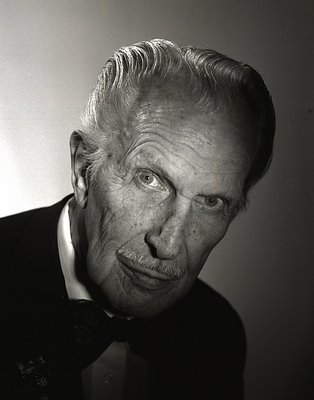
Every once in a while I have to re-file all my negs and slides. Originally they were in large metal filing cabinets. They are still there but while in the beginning I might have room for A's to be in an A cabinet now I have two drawers with all the As. I also have to expand my original author drawer. Thanks to all my dance photos, D is full. I love to file. This is how I find missfiles and nuggets that I may have forgotten I have. Sometimes I am startled in how imposing alphabetical order makes for the strangest "file" bedfellows. Here is an example that when I think about it isn't all that strange. If I had to find a common thread between actor Vincent Price and retired Vancouver Councillor Gordon Price (while considering that one of them is quite dead) I would say that it is culture. Whenever I went to the opera, ballet, art openings or lectures I would always run into Gordon Price. Few in Vancouver know that all city councillors have free seats at the Orpheum, Queen Elizabeth and the Vancouver Playhouse. Few councillors ever seem to take advantage of this. I recently talked to Gordon Price and he told me, "I really miss those seats, now that I am no longer a councillor."
While I didn't always agree with Gordon Price that I should ride a bicycle (instead of driving and polluting) with all my photo gear, tripods and lights in the dead of a rainy winter, I always knew that with him I had intelligence and objectivity in City Hall.
As for Vincent Price, I photographed him in Robson Square in 1986. He was gracious and I would say that if you compare pictures here you might agree with me that here we have some handsome bedfellows (if only in my files).
Gordon Price's Blog
Traveling Again
Wednesday, November 15, 2006
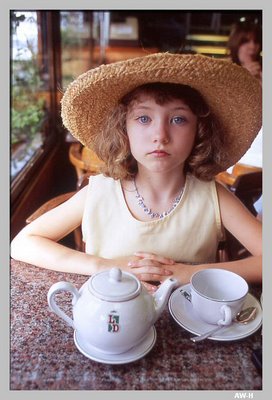
There is a curious smell in all the subways of the world and the Buenos Aires subte is no exception. It may be a combination of the electricity-generated ozone, rusting brake-pad dust and the hint of urine. I love the smell. I also love the noise and the flow of hot, dry air when another subte rushes by in the opposite direction. I thought I would never be able to share this nostalgia for my Buenos Aires youth. For me the shine had come off travel. I was wrong thanks to a little girl.
It all began in the summer of 2003 when my wife Rosemary and I went to Washington DC. We brought along our granddaughter Rebecca (then 6). At the National Gallery I plunked Rebecca in front of my favourite American painting. Rebecca looked at the two ducks, flying askew and said, “That’s Winslow Homer’s Right and Left.” Several of the museum goers present were quite startled and I smiled.
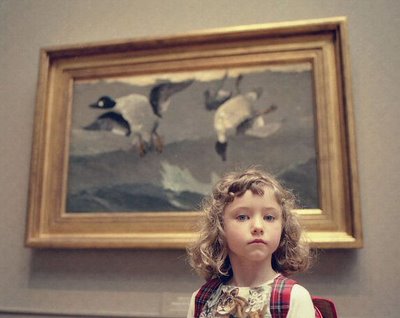
Before leaving for DC, I had shown Rebecca, in books from my library, three Francisco Goyas (one the portrait of the Duke of Wellington), one Leonardo Da Vinci (portrait of Ginevra de ‘Benci), one Jacques-Louis David ( Napoleon in his Study), Salvador Dali’s Sacrament of the Last Supper and my favourite Winslow Homer. These were the only paintings we saw at the National Gallery although we did take some extra time to stop at Edgar Degas’s sculpture, Little Dancer Aged Fourteen.
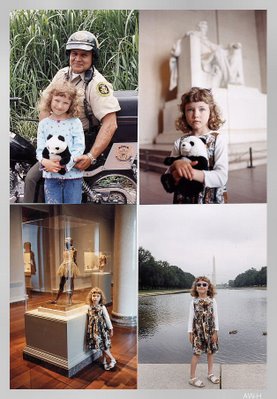
In the mid 80s 70s Rosemary, and our then teen and pre-teen daughters, Ale and Hilary and I had gone for a month’s trip to Europe. Our girls hated being dragged around the Louvre, the Prado, and the British Museum. They specially objected to the El Greco’s of Toledo. They wanted to shop or flirt with the handsome bell boys back at the hotel. Only in the beaches of Málaga did they finally stop sulking.
I did not know then what I know now: When you travel with children you travel for them. Our efficient sweep of the National Gallery in 2003 gave us the time to lunch at the venerable Willard Hotel, Rebecca held 4 inch long live cockroaches at the Museum of Natural History and we enjoyed at leisure an almost full day at the National Zoo. Best of all, Rebecca was not turned off to visiting museums as was the case with her mother Hilary years before.
So in December, 2004 we traveled to Buenos Aires and the beach resort of Punta del Este in Uruguay with Rebecca.
Our 18 hour flight to Buenos Aires (Vancouver, Toronto, and Santiago) was grueling but Rebecca slept through most of it with the help of the large pillow and blanket we had brought. In her little red carry-on she had her books and her felts for drawing. When we landed on Buenos Aires’s Aeropuerto Ministro Pistarini, Rosemary and I felt like tired rags while Rebecca was fresh and awake in spite of the 38 degree heat. It was like that for the rest of our three-week stay in Buenos Aires and Punta del Este. We always had to play catch up with her. It didn’t take long for Rebecca to adapt to the porteño habit of having dinner at 10 and going to bed past midnight.
By morning Rebecca required a schedule. This meant the usual hotel breakfast of café con leche and medias lunas de grasa (astounding croissants made with lard, not butter). I prepared her for the day by giving her quick descriptions of where we were going. During our day we made sure we stopped at cafes for café cortado (espresso with a shot of milk), Rebecca opted for orange Fanta or we had our dulce de leche tentación ice cream cones at the ubiquitous Freddos. At these stops and especially under the shade of the huge gomero (Ficus macrophylla or Moreton Bay fig tree) at La Biela coffee shop, Rebecca liked to open her traveling sketch book to draw or paste subway tickets and low denomination Argentine pesos. Rosemary had not forgotten to pack a glue stick. During the week we knew that the last subte to our hotel, the Park Elegance Kempinski, near the fashionable Recoleta district, was the 10:45. We didn’t worry, Buenos Aires taxis never seemed to exceed the Canadian equivalent of $2.00 on their meters or we walked.
We didn’t visit the elegant Teatro Colón opera house nor did we watch tango dancers at the Café Tortoni. In fact most people would say we didn’t see anything in Buenos Aires. But more than anything I wanted Rebecca to meet my very English relatives and show her a bit of my personal Buenos Aires. While we could have gone everywhere in the subte this was no way of seeing all the parks and beautiful boulevards. We walked up Avenida Santa Fe and stopped at all the shoe stores. A 7 year-old is no different from a 15 year old teenager! On the famous pedestrian Calle Florida Rebecca was enchanted by the street tango dancers and especially by an old gray-haired man dancing a 30s milonga with a young man in slicked back hair. Rebecca’s favourite stops (and mine, too) were the venerable old pizzerias like Las Cuartetas, Burgio, Los Inmortales and El Cuartito. We stood up for a porción de muzzarella [Argentine spelling] which Rosemary and Rebecca washed down with agua mineral while I had a glass of ice-cold moscato, a sweet wine that traditionally Argentines drink with their pizza.
Rebecca wanted to see penguins. We saw penguins and every other imaginable animal at the Zoológico including an ugly guanaco. At age 7, I had pointed and laughed at one. With a precise double hit the animal spat on my face (oh, the stench and the pain!). Rebecca laughed at my story and we kept our distance. Next door to the zoo, is the Jardín Botánico. It was here that the magic realism of Latin America leant itself to my Rebecca’s sensibilities. Besides having exotic plants and a notable collection of 19th century statuary the garden is famous for its cats, hundreds of them. It seems that porteños abandon their unwanted grown up kittens here. Rebecca picked up just about every one. A mysterious cat lover must feed them as they all looked in top shape.
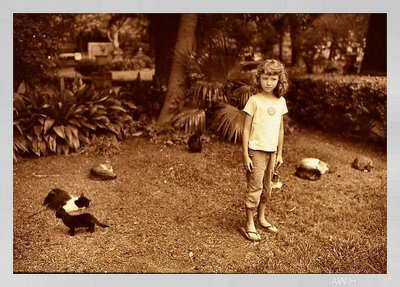
Rebecca’s most surprising contribution to our trip was her desire to go to places that were free. I never had much love for Eva Perón. I hated the useless wooden toys she gave us for Los Tres Reyes (the three kings of the Epiphany). I wanted a Meccano. But Rebecca had seen the film Evita so we had to go twice to the presidential palace, la Casa Rosada, to see the balcony from which she made her speeches. I chose not to mention the existence of the Eva Perón Museum. Nearby was the Catedral Metropolitana with the elaborate tomb to Argentine independence hero General Don José de San Martín. Guarding the entrance to the mausoleum were two 6 ft Granaderos de San Martín in their shakos and early 19th century uniforms. Rebecca went nuts snapping with her digital camera. Rosemary had insisted I buy her one. She was right. Rebecca nagged uso to see Evita’s tomb at the Recoleta cemetery. She chose to sketch it in her book. We stayed for three hours walking through the baroque and gaudy monuments to dead Argentine heros.
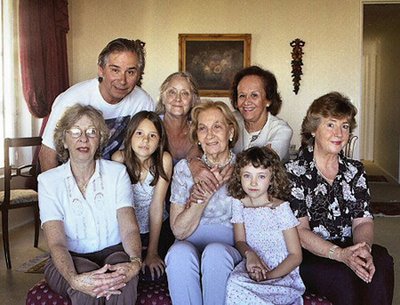
Rebecca agreed with me that my 84 year-old first cousin and godmother, Inesita O’Reilly ( centre in picture, right), sounded just like the queen of England when she poured our tea. Rebecca had to reluctantly switch to Spanish when she talked to my half-brother Enrique Waterhouse who refuses to speak English since he never met our English father. At the old fashioned San Telmo barrio Enrique took us to a cozy steak restaurant called La Brigada. Rebecca noticed that the waiter was cutting her steak with a fork and a spoon. For dessert, as part of Rebecca’s routine (and mine) we always had flan served with crema chantilly (whipped cream with sugar) and dulce de leche.
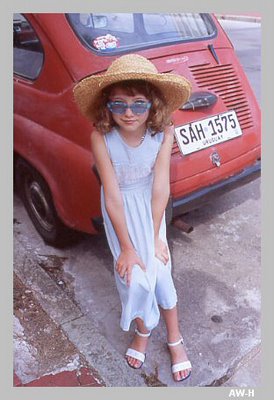
Once we arrived at Punta del Este Rebecca liked to eat at our apartment in the evening and she made it a habit to write postcards to her parents and friends. Part of the fun was going to the little post office to buy the stamps. We enjoyed the contrast of going in the colectivo (bus) to the playa mansa (calm) beach of the River Plate side of the peninsula on one day while on another we would enjoy the brava on the rougher Atlantic Ocean. From the point, a few blocks from our apartment, we could stand exactly where the ocean and the river meet. Looking South Rebecca, asked me, “Are there penguins down there? Where is our next adventure going to be?” I cannot wait. And I haven’t. Since going to Argentina we have gone to Guanajuato, Mexico (2005) and Morelia, Michoacán, Mexico (2006).
The Gondola By My Bed
Tuesday, November 14, 2006
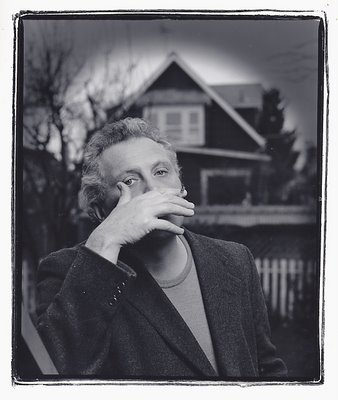
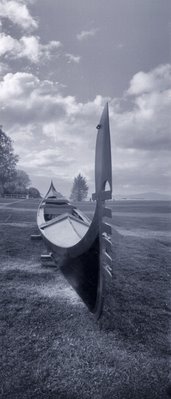
It 1953 my PANAGRA (Pan American Grace Airways) DC-6B from Buenos Aires landed in Managua, Nicaragua. From there I switched planes to Mexico City. It was a Pan Am Lockheed Constellation, in my opinion the most beautiful commercial airliner to fly. To this day I remember smelling Managua’s wonderful humid air when I walked on the tarmac to get to my plane. A beautiful and beautifully uniformed stewardess (the correct epithet then) offered me a stick of Wrigley’s Juicy Fruit in case my ears popped on take off. For me that was as good as travel ever got.
Now I avoid having to listen to, “For your comfort and safety please remain seated until…..” If I were to get instant discounts for not making the airport security check beep I might consider flying again. I would never board a cruise liner. They don’t go anywhere. In 1967 the Río Aguapey, an Argentine merchant marine Victory ship built in 1945 in the Burrard Docks in Vancouver, took me from Buenos Aires to Houston. The four-week voyage stopped in every Brazilian port on the way. I was the only passenger and when I wasn’t sunning myself or eating at the officers’ table a French-sounding concoction called an entrecott (it was always a steak), I read Spengler’s Decline of the West. Nothing of Spengler remains except a quasi Germanic memory of being chained to a yardarm with Prussian blue smeared on me when we crossed the equator.
I like to travel in the comfort of my bed with a large mug of Granville Island Tea Company's Earl Grey. With Alexandre Dumas I can go to 17th century Paris and not run into any American tourists. In Spanish I can read of similar situations in Madrid and the Spanish campaigns in Flanders in the delightful books of Arturo Pérez-Reverte. They feature the swashbuckling Capitán Diego Alatriste y Tenorio who would get along fine with D’Artagnan. Thanks to Celia Duthie, who introduced me to Arthur W. Upfield, and to my bibliophile friend Robert Blackwood who found most of the 28 out of print novels, I have followed Detective-Inspector Napoleon Bonaparte through most of Australia.
But my true passion is to read about Venice. The closest I have ever been to a Venice gondola is the one you see here that I photographed outside Vancouver's Maritime Museum. I like to visit the Venice of Vivaldi in such books as Gore Vidal's Vidal in Venice or Alejo Carpentier's Concierto Barroco. I follow Michael Dibdin’s (upper, left) shrewd but sad Venetian cop Aurelio Zen, solving a murder in his bleak city in the dead of winter in The Dead Lagoon. That may may be the finest novel I have ever read on Venice. It may be Acqua Alta but I don’t get wet. Last year I discovered (even though Robert Blackwood told me about her for years) Donna Leon’s Venetian novels in which commissario Guido Brunetti tries to solve crime and corruption with a little more success than figuring out exactly who his mysterious secretary Signorina Elettra really is. There are 15 in all and I have read all. And I need not feel guilty about staying in bed. After all Henry James wrote of Venice:
“Venice has been painted and described many thousands of times, and of all the cities in the world is the easiest to visit without going there.”
Thunderclap & Rain, One Countertenor, One Tenor & One Baritone
Monday, November 13, 2006
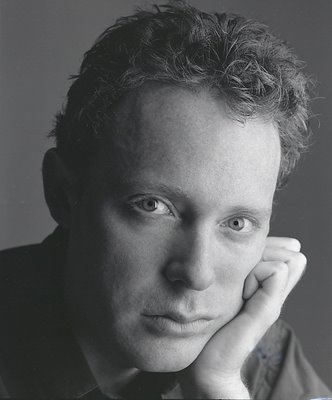
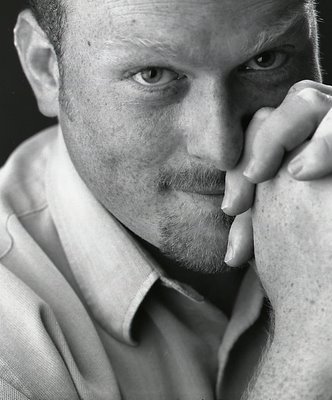
A rainy Sunday afternoon is extra special when one doesn't feel guilty about doing anything except cooking for one's wife and two granddaughters. Yesterday was even better since I listened to baroque operas including Handel's Rinaldo , performed by the Academy of Ancient Music directed by Christopher Hogwood. The cast included Cecilia Bartoli and American countertenor David Daniels. Rebecca jumped from her seat (she was at my computer) when she suddenly heard loud thunder. It was raining but it didn't come from outside, even though it seemed it did. For Rinaldo, Handel wrote thunderclaps and storms into the score, as well as actual songbirds. The exremely realistic thunder that scared Rebecca, was provided by an 18th century thunder machine belonging to the Drottingham Court Theatre.
As good as David Daniels is, we in Canada should not feel any particular jealousy as we have Montreal countertenor Matthew White (above) who visits and performs in Vancouver almost every year. It was in 2003 that both Rebecca and I saw our first baroque opera, Claudio Monteverdi's The Coronation of Poppea. It featured Matthew White and two other terrific Canadian singers, all seen here. Colin Balzer (right) is a tenor (in a pinch he has filled in for sick baritones) with amazing projection and diction (particularly in German). Balzer has an extra talent, not usual to young tenors. Since I last took this picture he has been losing so much weight that he has been buying suits and tuxedos as quickly as he can afford them.
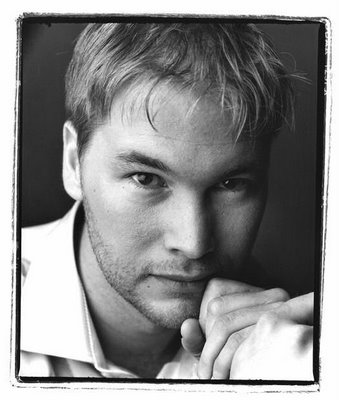
Tyler Duncan (left, and also quite slim) is a young Canadian baritone who lives in Germany. While I will be probably dead by the time Duncan is old enough and big enough to sing Wagner, I can assure you his German is perfect. He is also a good actor. Fortune has shined at him as he will be marrying Erika Switzer in December. Switzer (besides being beautiful and having perfect skin) is a fine pianist who often accompanies Duncan.
Tyler Duncan and Colin Balzer - Dec 19, 2006
Fave Matthew White recording
A Long Spring In Fall
Sunday, November 12, 2006
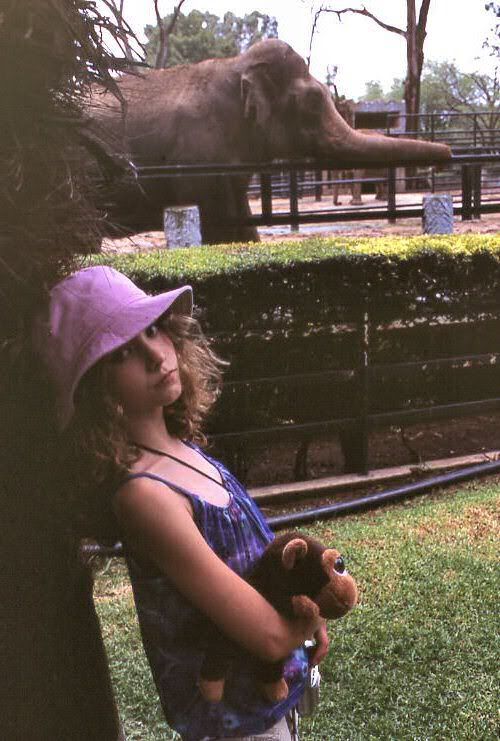
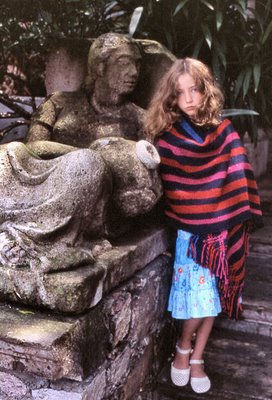
Rebecca, 9, has this fondness for stuffed animal toys. When she sees one she wants it. Her mother, Hilary has imposed a rule on her that forces to give away one of her old animals if she is to bring a new one to the house. In Morelia, last August Rebecca nagged us about a beaver (Chippy) she saw at Sanborn's. We pointed out the ludicrous fact that here you had a Canadian icon made in Indonesia that was being sold in Mexico. It didn't make any difference, she wanted it. When we went to the Morelia zoo (at 200 acres it is the largest zoo in Mexico) Rebecca insisted on taking George. Several generations of plush toys later I anger Rebecca when I tell her that she had abandoned Chippy for whatever animal is her favourite at the moment. She insists, "Chippy is at home in my room and he is happy with Rose, Evelyn,......"
I explain to Rebecca about adult things. We talk about Hitler and evil or I teach her about how sadly Paul Desmond played his alto saxophone the day his mother died (I was there). Hilary, her mother and my wife Rosemary insist that Rebecca needs to be the little girl she is. Perhaps Hilary insists more than Rosemary. I catch myself when I almost begin to say to Rebecca, "Rebecca, you are 9, you don't need another stuffed animal."
Yesterday we all went to VanDusen for a walk. This is a favourite place for Rebecca and Lauren. Lauren, in particular, likes to get lost in the maze. Rebecca and I touched rhododendron leaves to see which would have that soft indumentum that reminds us of the inside of a cat's ear or, even, of one of Rebecca's animals.
But Rosemary and I knew that as soon as we finished the walk we were going to have a problem at the VanDusen store. Rebecca wanted one of the bears. I tried to explain to Rebecca that as soon as it is about mid November it is useless to ask for anything. Christmas is just around the corner. Rebecca almost began to cry as I taunted her with the spelling of no in Spanish, "¡ N-O, no! over and over until Rosemary told me to shut up. In the car I told Rebecca that if I were a millionaire I would never be able to say no to her.
And I always remember that quote from Dag Hammarskjöld's Markings:
You find it hard to forgive those who, early in life, have come to enjoy the advantages that come with maturity. Aside from any other consideration, why don't you put into the balance the long spring enjoyed by a youth who matured late.
Rebecca, don't grow up; not just yet.
Staff Sargeant James Wallwork & Daphne du Maurier
Saturday, November 11, 2006
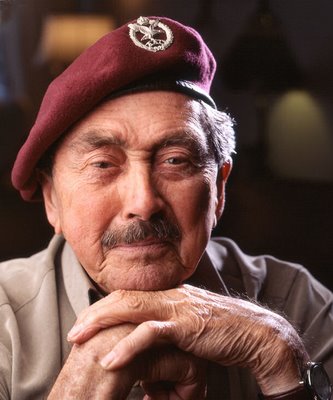
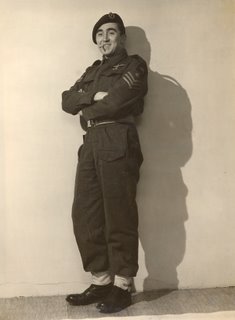
On the early hours of June 6, 1944 (0007 minutes after the invasion of Normandy had started) Staff Sargeant James Wallwork, glider pilot, cast off his Horsa glider from the Halifax bomber that was towing him. At that instant, the invasion had really begun. There were 156,000 men prepared to go into France that day, by air and by sea, British, Canadian and American, organized into some 12,000 companies. D Company's 160 men under the commmand of Major John Howard in 6 gliders (Number 1 was Wallwork's) led the way. It was the only company attacking as a completely independent unit. When Wallwork cast off, D Company was alone.
At 0016 Wallwork's No 1 (Irene) landed (a controlled crash) very near the Bénouville Bridge(later renamed, most famously, the Pegasus) on the Caen Canal. The crash sent Wallwork and his co-pilot, Staff Sargeant Ainsworth out of the cockpit, through the perspex canopy and into the ground. Wallwork was the first allied soldier on occupied French soil.
This magnificent performance and that of the other 5 Horsa gliders was praised by Air Vice Marshal Leigh-Mallory, commanding the Allied air forces on D-Day, as the greatest feat of flying of World War II.
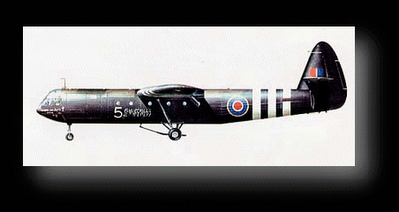
When I called James Wallwork (British born but now a Canadian) yesterday he told me he was 87 and was getting ready to march today with the troops in Ladner. He will not be seeing this blog because his wife Genevieve has disconnected "the magic lantern" for 6 months.
In 1942 when Britain's first airborne troops were formed, the 1st Airborn Division, Daphne du Maurier, wife of the commander, Major-General F.M.A. 'Boy'Browning, suggested a maroon beret for the troops. Bellerophon was to be astride winged Pegasus as the airborne shoulder patch and symbol, pale blue on a maroon background. You can see Wallwork (above left) with his maroon beret as I photographed him in 2004. The other photograph is of Wallwork in London in 1943.
Barbara Sukowa Seduces & Max von Sydow Springs A Smile
Friday, November 10, 2006
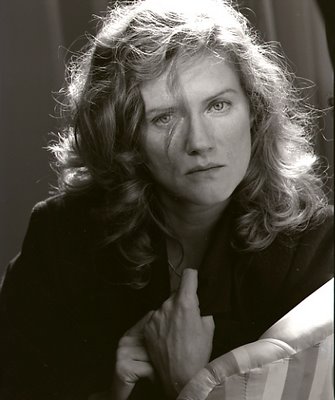
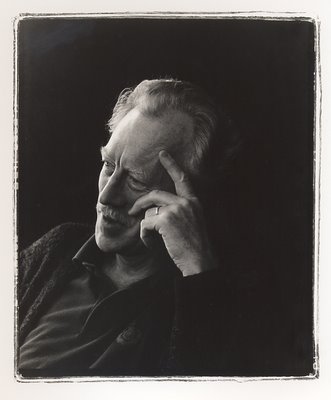
One of the most horrific films I have ever seen, I saw with John Lekich in 1991. The German film, Europa directed by Danish Lars von Trier, began with a man who was underwater, struggling to free himself from a rope or plant. A voice that could only be (and was) Max von Sydow said, "At the count of 10 this man will die." Then von Sydow began his lugubrious countdown. At 0, the man no longer moved.
The female lead was the ravishing Barbara Sukowa. The Georgia Straight had dispatched John Lekich and me to the Hotel Vancouver for the interview and the portrait session. Sukowa was in town for that year's Vancouver Film Festival. I took some pictures of Sukowa using a lighting technique (grid spots) that enhanced her striking eyes. What I told her before I took the picture , I could never repeat in our politically correct 21st century, "Seduce me through the lens of my camera."
A year later when Max von Sydow was a guest at the same film festival I photographed him in the Vancouver Hotel's Sun Room. I almost always light my subjects and for this occasion I had my lights ready in a corner. But when I saw von Sydow looking out of window during his interview, I snapped this with my camera's long lens. When he finally faced my lights, I told him how his voice had affected me in Sukowa's movie. He looked back seriously but he smiled (below) when I told him under what circumstances I had seen my first art film, his 1960 film The Virgin Spring. I was 17 and it was my last year in a Catholic boarding school in Austin, Texas. I told my three roomates, "I think it's about time we all went to see a "dirty" movie. We looked at the paper and saw The Virgin Spring, we figured that was the one.
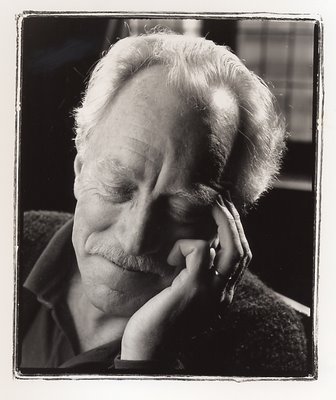
John Ford & Sun Yat-Sen
Thursday, November 09, 2006
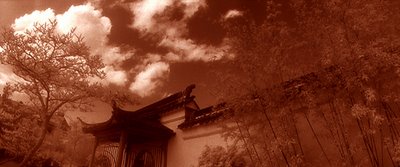
Sometime in 1992 I was taking panoramic photographs of all of Vancouver's botanical gardens. Right after a storm I decided to go to the Sun Yat-Sen Classical Chinese Garden. I was using an unreliable swivel lens panoramic, a Widelux, with Kodak b+w infrared film. This made the combination even more unreliable. But I did get a few good photographs of which this one I titled for a gallery show, If John Ford Had Made The Movie, Sun Yat-Sen Would Have Been John Wayne. Nobody that read the title understood it.
Tuesday night I looked forward the airing of Peter Bogdanovich's documentary Directed By John Ford on the Turner Classic Movies TV channel. I was not disappointed. I specially appreciated Steven Spielberg's account on how he met John Ford when Spielberg was a 15 year-old boy. Told by Ford to look at a series of Western paintings on the wall and tell him what he saw, the young Spielberg saw only narrative — an Indian on a horse, etc. Ford told him to look at the composition, look at the horizon line — it was low in one picture, high in another picture.
"When you can decide that putting the horizon at the top of the frame or the bottom of the frame is better than putting it in the middle of the frame, you may, someday, make a good picture maker. Now get outta here."
Bogdanovich then cut to a series of Ford landscapes that show that the horizon line is never in the center of the frame. The man practiced what he preached.
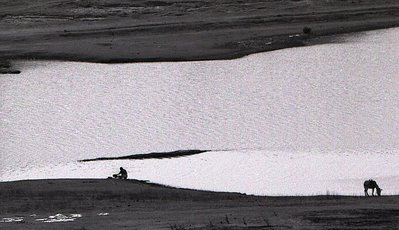
For years I have been explaining to my photography students the "day for night" technique used by John Ford in which you would see bilowy white clouds in evening skies. The trick with b+w movies was to underexpose while using a deep red filter. It was the deep red filter that gave me that "John Ford" sky over Sun Yat-Sen.
Frank, John, Maddalena & A Davit Imperial
Wednesday, November 08, 2006
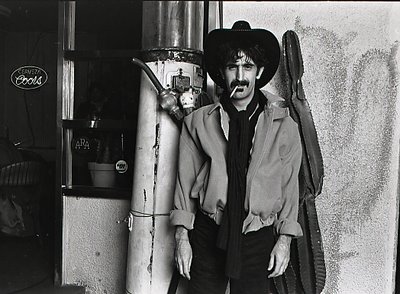
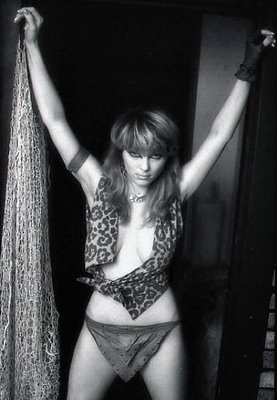
A week ago I was taking photographs of shoe designer John Fluevog on Granville Street. I told him that he and Frank Zappa had one thing in common. Fluevog looked at me perplexed and I explained it all had to do with the davit imperial. I pointed at his soul patch (which Fluevog called an imperial) and told him that I had photographed Zappa in 1980. I had asked him what he called the hairy protuberance under his lower lip. Before he could reply a waiter at Bud's Good Eats asked him what he wanted to drink. Zappa asked for the list of beers. The waiter mentioned over 15 brands. Zappa said, "Bring me a ginger ale," and looking at me, "a davit imperial."
Buds Good Eats served Tex/Mex food beginning sometime in 1979. In the last 10 years it became Carlos and Bud's. Since it has always been prime land, right next to the on ramp to the North end of the Granville Street Bridge, it recently closed to make way to yet another condo development. When I saw the boarded up windows recently I thought of my friend Maddalena di Gregorio (who along with the Reid sisters taught me a few things on how to photograph a woman).
Before she left for Montreal some 12 years ago on her way to Milan (where she is now) she invited me for a drink at Buds Good Eats. It was a hot summer afternoon and we sat in the patio. I told her that I had particularly treasured her taking me to Carlucci's on East Hastings. I soon discovered that Carlucci's offered more delights besides their succulent gnocci. While Mama Carlucci did not sport the davit imperial ( she grew a generous mustache), Signorina Carlucci was Sophia Loren with a vacuum cleaner. If you arrived for a late lunch, Signorina vacuumed the restaurant. Imagine Marilyn Monroe in the Misfits in that tight polka dot dress smacking that ball with the rubber band and the paddle.
As far as I can tell Maddalena was never tempted to grow a davit imperial.
Tara Jean Wilkin, Gary Bannerman and Janet Leigh
Tuesday, November 07, 2006
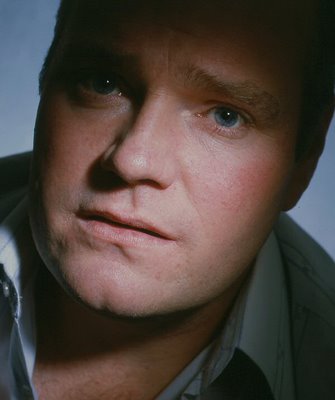
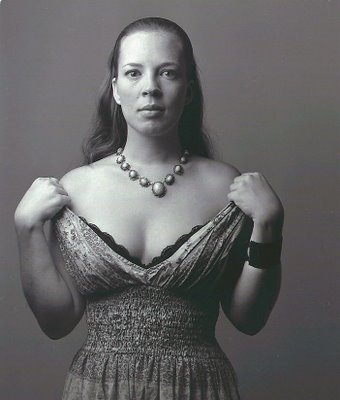
When I first met veteran talk radio host Gary Bannerman I was shocked at his size. He was very tall and intimidating. I had gone to his office to photograph him for Vancouver Magazine. I knew I was going to have a successful shoot because of an event that preceded my session with him. I was waiting for the elevator, surrounded by all my equipment and lights, when the door opened. Out stepped Janet Leigh who stared right at me. While most associate her with Psycho I was always a sucker for her beauty in one of the worst movies of all time, the 1954 The Black Shield of Falworth, where she played alongside her husband Tony Curtis. I knew I was going to get a good photograph of Bannerman.
Somehow in my photograph Bannerman lost his cool and it seems my camera peeked into a fragile man that few know. Interviewing Janet Leigh must have been an experience that left him drained and ripe for my camera.
Just about a month ago actress Tara Jean Wilkin walked into my studio looking like this (right). I instantly remembered Janet Leigh.
Virve Reid - A Baltic Surprise
Monday, November 06, 2006
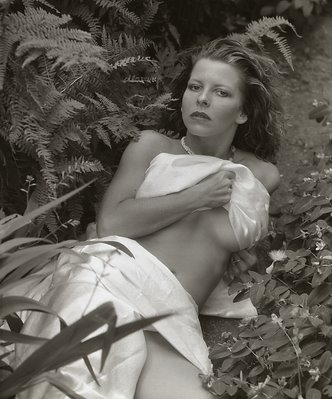
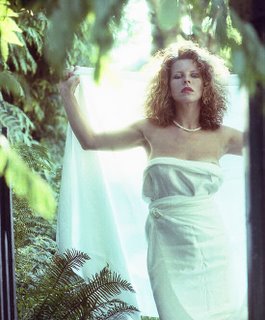
Vancouver Magazine editor of yore, Malcolm Parry wasn't completely wrong but he almost ruined my reputation as a photographer in Vancouver. He used to say, "I want you to meet Alex Waterhouse-Hayward, the photographer who, curiously, can make beautiful women ugly and ugly women uglier." For a while I believed him so I tried to perfect some technique and prove him wrong. Along the way I had a few very patient subjects who posed for me willingly and helped me along. The best of all of them was and is the voluptuous Baltic surprise, Virve Reid with her flaming red hair and beautiuful white skin. She was the first Canadian redhead to appear (undraped) in the centrefold of a known American magazine. Virve is from that generation of women that was either satisfied with her body or kept her mouth shut and never complained. While she was flawless, I am sure that a present generation would find room for surgical correction.
I did not know what I was shooting. Was I doing glamour (with that almost obscene u that even Americans keep) or was I doing erotic or nude photography? I wasn't sure but Virve posed for me with terrific patience while I sorted it all out. Here are a couple that I took in my garden sometime in 1987 or 88. Thanks to Virve (and her sister Julia) I was eventually able to gain some confidence but Mac changed his tack. Now he introduced me as, "This is Alex, Halfstop, Waterhouse-Hayward." The nickname came from the fact that I tried to avoid, at all costs, overexposing my colour slides. When Mac, Rick (Staehling) or Chris (Dahl) would note that my pictures were too dark I always pointed out to them that I had bracketed by half a stop.
Julia Reid - Another Baltic Surprise
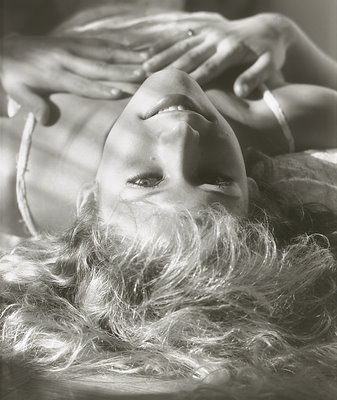
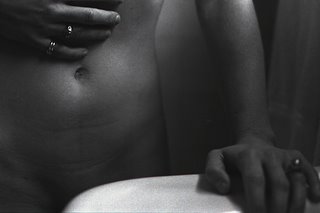
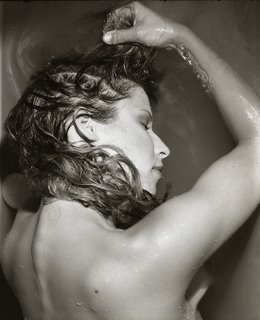
Virve could be difficult (picky) sometimes, but her sister Julia was more laid back. Whenever I called Julia up to ask her to pose she was instantly available. My photographs of her in her tub (as well as Virve's) became my prototypes for a series I did later of tub shots. Julia posed for me once in her West End bathroom apartment for a group of shots of which I can only show one since I made the decision that I would post no revealing photographs here. What a pity!
The Kris Plant - Alocasia sanderiana
Sunday, November 05, 2006
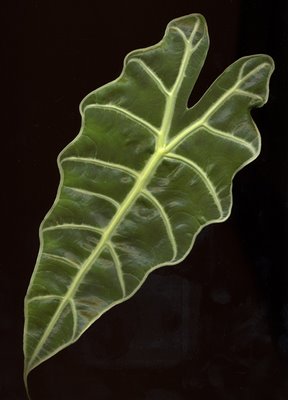
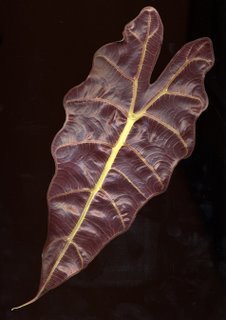

The Genera of Araceae
The Araceae are a family of herbaceous monocots with 104 genera and about 3700 species if the Lemnaceae is not regarded as a generic synonym, or 108 genera and about 3750 species if the Lemnaceae are included.
The vast majority of the genera occur in the New World tropics. Members of the family are highly diverse in life forms, leaf morphology, and inflorescence characteristics. Life forms range from submerged or free-floating aquatics to terrestrial (sometimes tuberous), and to epiphytic or hemiepiphytic plants or climbers. Leaves range from simple and entire to compound and highly divided, and may be basal or produced from an aerial stem. The family is best characterized by its distinctive inflorescence, a spadix with bisexual or unisexual (sometimes with sterile region) and subtended by a solitary spathe on a long or very short peduncle.
It is only recently, that I found out that the kris plant, that my grandmother told me about when I was a little boy, was an aroid and that its botanical name is Alocasia sanderiana. It is called a kris plant because the leaves of this plant which have metallic gray veining resemble a kris a Filipino knife from the island of Mindanao. This southern island of the Filipino archipelago, has a majority Muslim population that the Spaniards, who occupied the Philippines until the Spanish American war, called moros or "moors". These Malay people came from Indonesia and imported mny customs including the asymmetrical kris. Aloacasia sanderiana is a Filipino native plant.
If a family of plants might have come from another planet the aroids are prime candidates for strangeness. The stinky Amorphophallus from Indonesia may have the largest flower (properly called an inflorescence) on earth. Some arisaemas (Jacks in the pulpit)choose not to emerge in the spring in my garden in some years and when I think they are long gone there they are. They change sex at will like many aroids. There are some aroids that are able to raise the temperature of their flowers (and we though that only some animals could be warm blooded!). Calla lilies (Zantedeschia), the indoor monstera or Swiss Cheese plant are also aroids.
The direct scans of a leaf of my Alocasia sanderiana (note the purple underside) from a plant that I have had in my house for 20 years. At first I thought that when all the leaves of the plant collapsed that the plant had died. I would water it. That would finish off the plant and it would die. I soon learned not to water it and leave it alone until early spring. My pristine plant is not so pristine. Even though the leaves have a caustic sap my female cat, Plata, delights in chewing at them.
Betty Sommerville, Malaspina Printmakers & Lauren Stewart
Saturday, November 04, 2006
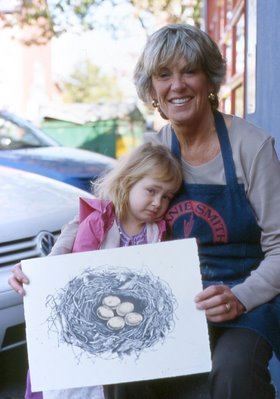
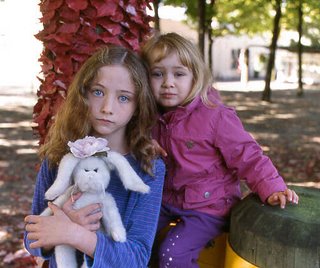
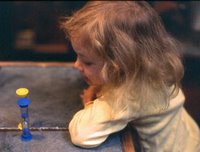
I can safely say that of all the many designers I have worked with in all my years in Vancouver, the one who always gave me free reign and (most important) never nagged about, "When is it going to be done?" was and is Elizabeth Sommerville whom we all call Betty. She is now dedicating her time (and would you believe, successfully?) to making etchings and stuff at Malaspina Printmakers. She is there with my other two artist friends Graham Walker and Rosamond Norbury. For a small service rendered, Betty offered to pay with a couple of her works. I jumped at the opportunity as Lauren's sister, Rebecca has a Graham Walker etching. Here was an excellent opportunity for Lauren (4) to begin her art collection. Betty's nest was perfect and here you see Betty with Lauren in a recent fall day at Granville Island. Lauren loves to play with the sand clocks that some of the tea drinkers use at the Granville Island Tea Company. I just wait for my Organic Tanzanian to be as strong as possible.
Waiting for Rebecca to come out from her Arts Umbrella jazz class with Edmond Kilpatrick Lauren and I noticed the strange way that fall leaves fall on the island so we decided to document the event with my Nikon FM and its 50mm F-1.4 lens and, of course with Blossom the rabbit.
Friday, November 03, 2006
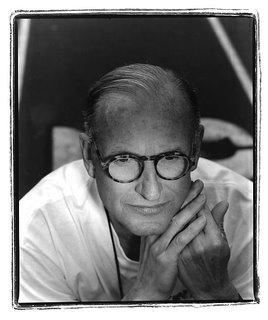

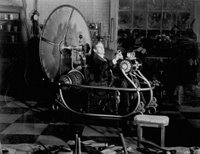
On Wednesday night, at the opening performance of the Arts Club Theatre Company's The School For Scandal my laughs (this is a very funny play) were dampened by a reality that became too obvious as the evening progressed. I only counted two actors on stage that I had previously photographed, Colin Heath and Christopher Gaze. But amongst the audience I recognized at the very least 50 people, who were or are friends, actors, business people, doctors of medicine, that I have photographed in the past and recent past. Some of them stared at me not quite remembering where they had seen me. We photographers can be transparent. I first photographed Bill Millerd, the artistic managing director of the Arts Club about 30 years ago. He would not have remembered me now and there he was. So was sports doctor Doug Clement (above left) and research scientist Julia Levy.
The evening reminded me of 1960 film The Time Machine with Rod Taylor. In the film, when Rod Taylor as George (H.G.) Wells straps himself to the time machine and moves into the future, rapid projections behind him show the future (some initial flashes are WW I, the next are WWII, in between, trees grow and die quickly, cities appear and then disappear. The people crowding the Stanley Theatre lobby reminded me of these scenes, but in slow motion.
I thought of the saddest words I have read in many years, in Harold Bloom's How To Read and Why (2000). In the preface he writes:
"We read not only because we cannot know enough people, but because friendship is so vulnerable, so likely to diminish or disappear, overcome by space,time, imperfect sympathies, and all the sorrows of familial and passional life."
It was around 1958 that I placed my brand new Pentacon F on a tripod and took (self timer) a group picture of my room mates at St Edward's High School in Austin Texas. This view is towards town and by now the field must be gone. From left to right, it is John Arnold, Mac Letscher, me and Melvin Medina. I have lost contact with all of them. I last saw John Arnold 25 years ago when I returned to Texas to have a look at my school. I met up with John Arnold and other classmates,poolside, at a Houston Holiday Inn. it was nighttime and 105 degrees. John had fought in Vietnam and with his crisp white short sleeved dress shirt he looked like a spook. He told me he worked for a security firm. Others had died in that war.
I look at this picture now and it is no different from those flickering shadows behind Rod Taylor's time machine.
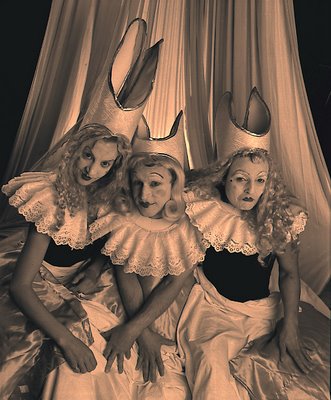
Last night Rosemary and I attended the opening performance of The School for Scandal by 18th century Irish playwright Brinsley Sheridan at the Stanley. This Arts Club Theatre Company production went at a brisk pace as it was directed by the ever funny Dean Paul Gibson. Rosemary and I laughed lots during the evening. The dialogue is quick and funny. But funnier still was Christopher Gaze as both Mr Crabtree and the servant Humphreys. Gaze did not need to say anything to be funny. His movements and his face were enough. His only competition came from Colin Heath in one of those rare appearances on a stage, minus dogs and small scary children. I was elated and proud to find out that Vancouver (with its short memory) has not yet forgotten this former member of the Leaky Heaven Circus who now lives in Toronto with Manon Beaudoin and their dogs and scary children. When the diminutive actor first appeared on stage we clapped.
In last year's production of the Leaky Heaven's Bonobo complete with dogs and scary children plus with that other paragon of laughter and acting virtuosity, Lois Anderson, Rebecca (my granddaughter), Ale (my eldest daughter) and I laughed all evening. But we were sad to find out that it was the end of that trio of ever so funny (in that chaotic Leakey Heaven Circus way) and that Colin and Manon were moving East.
Last night's performance of The School for Scandal proves that the Arts Club Theatre brand of intelligent humour is not dead. It proves that we should make sure that Dean Paul Gibson remains with us, and, who knows could the Leaky Heaven Circus bring back Colin, Manon, Louis and add Christopher Gaze? Wow!
In the picture here, from left to right, Lois Anderson, Colin Heath and Manon Beaudoin.
The School for Scandal
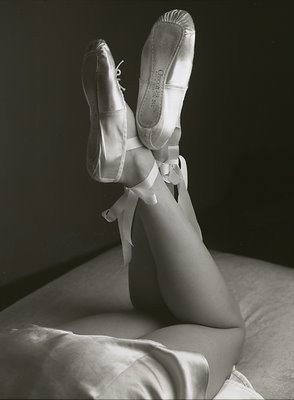
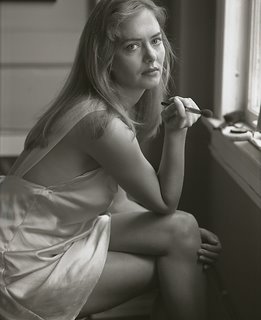
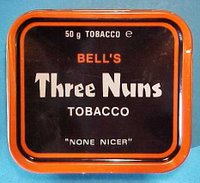
If my memory does not fail me it is that scene in Arch of Triumph (1948) where Charles Boyer and Ingrid Bergman do the cigarette thing. He lights two cigarettes and gives her one. When I saw that scene it was exquisitely romantic. In 2006 I would probably have to supress my excitement and tell you that smoking is a disgusting habit. I have kept all the pipes I ever owned in case I ever change my mind (not likely). I had as many pipes as I would smoke in a day, 5. Multiplied times 7 that makes 35. This meant that every pipe I smoked once would rest (and dry up) for a week, before I smoked it again. My favourite pipe tobacco was Bell's Three Nuns . They advertised as "None Nicer".
The same feeling of romance paseé has ocurred for me when I think of high heel shoes. They look uncomfortable and they don't do anything for my receding libido.
But ballerina slippers, that's another thing, altogether! I took my first ballerina slippers shot around 15 years ago. My subject was Reneé Michelle. But it easily could have been Michelle Reneé. Even 15 years ago I was confused about her name. I photographed her once in my Robson Street studio and I remember this photograph ever so fondly. It is a pity I cannot justify lighting one of my favourite Petersen (Dublin) pipes with some Three Nuns.



On Wednesday night, at the opening performance of the Arts Club Theatre Company's The School For Scandal my laughs (this is a very funny play) were dampened by a reality that became too obvious as the evening progressed. I only counted two actors on stage that I had previously photographed, Colin Heath and Christopher Gaze. But amongst the audience I recognized at the very least 50 people, who were or are friends, actors, business people, doctors of medicine, that I have photographed in the past and recent past. Some of them stared at me not quite remembering where they had seen me. We photographers can be transparent. I first photographed Bill Millerd, the artistic managing director of the Arts Club about 30 years ago. He would not have remembered me now and there he was. So was sports doctor Doug Clement (above left) and research scientist Julia Levy.
The evening reminded me of 1960 film The Time Machine with Rod Taylor. In the film, when Rod Taylor as George (H.G.) Wells straps himself to the time machine and moves into the future, rapid projections behind him show the future (some initial flashes are WW I, the next are WWII, in between, trees grow and die quickly, cities appear and then disappear. The people crowding the Stanley Theatre lobby reminded me of these scenes, but in slow motion.
I thought of the saddest words I have read in many years, in Harold Bloom's How To Read and Why (2000). In the preface he writes:
"We read not only because we cannot know enough people, but because friendship is so vulnerable, so likely to diminish or disappear, overcome by space,time, imperfect sympathies, and all the sorrows of familial and passional life."
It was around 1958 that I placed my brand new Pentacon F on a tripod and took (self timer) a group picture of my room mates at St Edward's High School in Austin Texas. This view is towards town and by now the field must be gone. From left to right, it is John Arnold, Mac Letscher, me and Melvin Medina. I have lost contact with all of them. I last saw John Arnold 25 years ago when I returned to Texas to have a look at my school. I met up with John Arnold and other classmates,poolside, at a Houston Holiday Inn. it was nighttime and 105 degrees. John had fought in Vietnam and with his crisp white short sleeved dress shirt he looked like a spook. He told me he worked for a security firm. Others had died in that war.
I look at this picture now and it is no different from those flickering shadows behind Rod Taylor's time machine.
Colin Heath, Humphreys & Not A Dog In Sight
Thursday, November 02, 2006

Last night Rosemary and I attended the opening performance of The School for Scandal by 18th century Irish playwright Brinsley Sheridan at the Stanley. This Arts Club Theatre Company production went at a brisk pace as it was directed by the ever funny Dean Paul Gibson. Rosemary and I laughed lots during the evening. The dialogue is quick and funny. But funnier still was Christopher Gaze as both Mr Crabtree and the servant Humphreys. Gaze did not need to say anything to be funny. His movements and his face were enough. His only competition came from Colin Heath in one of those rare appearances on a stage, minus dogs and small scary children. I was elated and proud to find out that Vancouver (with its short memory) has not yet forgotten this former member of the Leaky Heaven Circus who now lives in Toronto with Manon Beaudoin and their dogs and scary children. When the diminutive actor first appeared on stage we clapped.
In last year's production of the Leaky Heaven's Bonobo complete with dogs and scary children plus with that other paragon of laughter and acting virtuosity, Lois Anderson, Rebecca (my granddaughter), Ale (my eldest daughter) and I laughed all evening. But we were sad to find out that it was the end of that trio of ever so funny (in that chaotic Leakey Heaven Circus way) and that Colin and Manon were moving East.
Last night's performance of The School for Scandal proves that the Arts Club Theatre brand of intelligent humour is not dead. It proves that we should make sure that Dean Paul Gibson remains with us, and, who knows could the Leaky Heaven Circus bring back Colin, Manon, Louis and add Christopher Gaze? Wow!
In the picture here, from left to right, Lois Anderson, Colin Heath and Manon Beaudoin.
The School for Scandal
Three Nuns & A Ballerina With The Reversible Name
Wednesday, November 01, 2006



If my memory does not fail me it is that scene in Arch of Triumph (1948) where Charles Boyer and Ingrid Bergman do the cigarette thing. He lights two cigarettes and gives her one. When I saw that scene it was exquisitely romantic. In 2006 I would probably have to supress my excitement and tell you that smoking is a disgusting habit. I have kept all the pipes I ever owned in case I ever change my mind (not likely). I had as many pipes as I would smoke in a day, 5. Multiplied times 7 that makes 35. This meant that every pipe I smoked once would rest (and dry up) for a week, before I smoked it again. My favourite pipe tobacco was Bell's Three Nuns . They advertised as "None Nicer".
The same feeling of romance paseé has ocurred for me when I think of high heel shoes. They look uncomfortable and they don't do anything for my receding libido.
But ballerina slippers, that's another thing, altogether! I took my first ballerina slippers shot around 15 years ago. My subject was Reneé Michelle. But it easily could have been Michelle Reneé. Even 15 years ago I was confused about her name. I photographed her once in my Robson Street studio and I remember this photograph ever so fondly. It is a pity I cannot justify lighting one of my favourite Petersen (Dublin) pipes with some Three Nuns.






